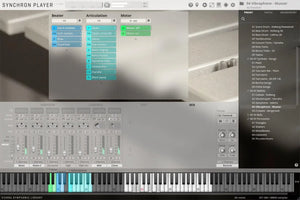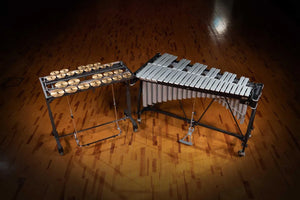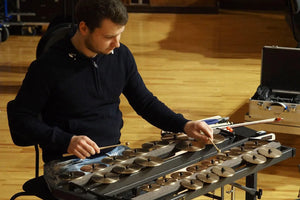Your Cart is Empty




Vienna Synchron Mallets II Standard
Contains a vibraphone and crotales
TEST4b
$0.00$95.00Description
Synchron Mallets II
Synchron Mallets II is part of the Synchron Percussion II Collection and contains a vibraphone and crotales.
The Vibraphone was developed in 1921 by the Leedy Manufacturing Company in the USA. Due to its quick popularity, it was developed further by the same company in 1927, when it got its now familiar form with aluminum sound bars. Vibraphones have a pleasant soft sound equally suited for melodies and harmonic accompaniment. In comparison with other mallet instruments, its sound has a relatively long sustain. As with the piano, the tone can be held with a pedal. Vibraphones also have a motor that turns so-called butterfly valves over the resonator tubes, thus creating a vibrato effect.
The vibraphone featured in Synchron Percussion II was recorded with up to eight dynamic layers and eight round robins for single strokes. It provides the following articulations: motor on and off, hard and soft mallet, single notes open and secco, and rolls. Effect techniques include pitch bend (to achieve this, a hard mallet is drawn with pressure over the sound bar), harmonics (the sound bar is pressed in the middle and played at its suspension point), glissandos as well as being played with the mallet handle, rubbed with a super ball, and bowed.
The Crotales used in today's orchestras descended from antique cymbals and were first used during the Bronze Age in Ireland. Originally, antique cymbals were played in pairs by striking each other. Modern orchestral crotales consist of individual brass or bronze discs arranged in half tone steps. They have a very bright, bell-like sound with a relatively long sustain, which makes them similar to the glockenspiel. They are often used for melodies or for doubling leading voices.
The crotales of Synchron Percussion II are available in a range of two octaves (C6"C8). They were played with plastic and metal beaters, and sampled with up to eight dynamic layers and four round robins. Rolls, glissandos and bowed articulations are included as well.
12 Microphones
Every instrument was recorded using 12 microphones. You may select from four microphone positions (Standard Library) and mix them to your liking, directly in the Vienna Synchron Player. Use the included and perfectly fine-tuned presets as a starting point for your own sonic creations. The performances in Stage A were captured in stereo using a Decca tree, and additional microphone arrays were utilized for 5.1 surround and Auro 3D 9.1.
Microphone Positions of the Standard Library:
- Close Mic " Mono
- Mid Layer Mic " Stereo (L/R)
- Main/Room Mic " Decca Tree Stereo (L/R)
- Main/Room Mic " Decca Tree Mono (Center)
Tech Specs
System Requirements
Minimum:
- Windows 10 (latest update, 64-bit), Intel Core i5 or AMD Athlon 64 X2
- macOS 10.14 Mojave (latest update), Intel Core i5
- SSD (M2, SATA 6 or USB3/3.1, UASP Support - HFS+, APFS or NTFS formatted)
- Please check Vienna Symphonic Library website for full RAM requirements
- iLok Account and iLok License Manager for license activation on a physical iLok 2/iLok 3 key or in an iLok Cloud Session (the iLok Cloud requires a constant internet connection!)
- Free storage space for Library, please check Vienna Symphonic Library website for space requirements
Recommended:
- Windows 11 (latest update), Intel Core i7/i9/Xeon
- macOS 13 Ventura (or higher), Intel Core i7/i9/Xeon/M1/M2
- Please check Vienna Symphonic Library website for full RAM recommendations
- AU/VST/VST3/AAX Native compatible host
- 88 key master keyboard







